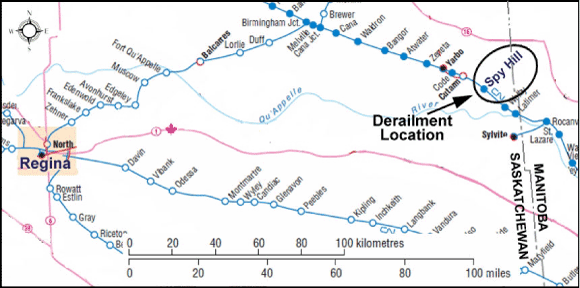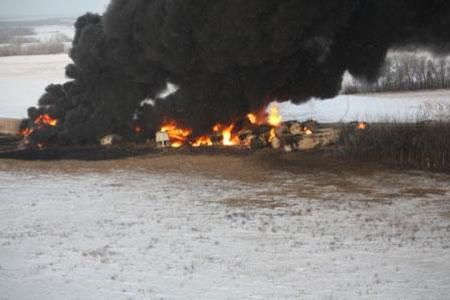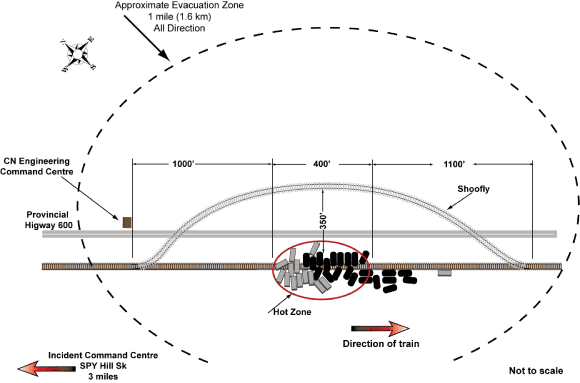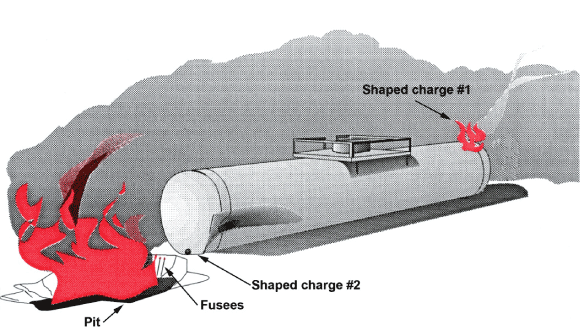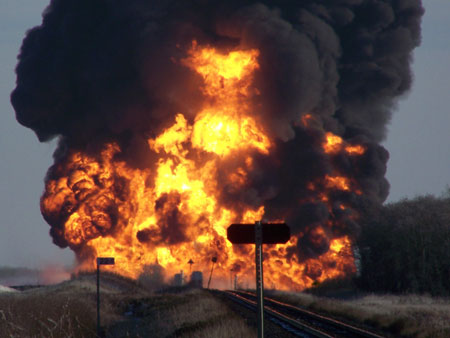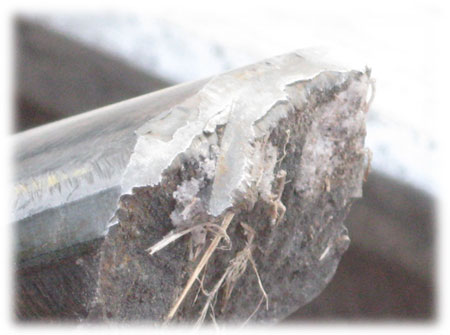Main-track train derailment
Canadian National
Freight train Q11459-03
Mile 222.90, Rivers Subdivision
Spy Hill, Saskatchewan
The Transportation Safety Board of Canada (TSB) investigated this occurrence for the purpose of advancing transportation safety. It is not the function of the Board to assign fault or determine civil or criminal liability. This report is not created for use in the context of legal, disciplinary or other proceedings. See Ownership and use of content. Masculine pronouns and position titles may be used to signify all genders to comply with the Canadian Transportation Accident Investigation and Safety Board Act (S.C. 1989, c. 3).
Summary
On 05 December 2009, at about 0700 Central Standard Time, Canadian National freight train Q11459-03 proceeding eastward on the Rivers Subdivision near Spy Hill, Saskatchewan, derailed 36 cars, including 22 tank cars loaded with dangerous goods, at Mile 222.90. Dangerous goods were subsequently released, resulting in a fire, which initially involved 34 of the cars and burned for 6 days. All residents within a 1.6 kilometre radius were evacuated. Approximately 400 feet of track was destroyed. There were no injuries.
Ce rapport est également disponible en français.
Factual information
On 05 December 2009, Canadian National (CN) freight train Q11459-03 (the train) departed Melville, Saskatchewan, on the Rivers Subdivision destined for Winnipeg, Manitoba. The train consisted of 2 head-end locomotives and 168 cars (142 loads, 26 empties). It weighed 12 423 tons and was 10 995 feet long. The train's operating crew consisted of a locomotive engineer and a conductor. They were both familiar with the subdivision, met fitness and rest standards and were qualified for their respective positions.
The accident
Following departure, the train received a wayside crew inspection, passed several hot box and dragging equipment detectors and a Wheel Impact Load Detector (WILD), located at Mile 232.40. No exceptions were reported. The train passed through the town of Spy Hill, Saskatchewan, (Mile 225.80) and, at about 0700,1 while travelling at 50 mph with the throttle in idle, there was a bump in the cab of the lead locomotive. This was followed by an undesired emergency application of the train's air brakes. The train derailed, an explosion occurred and a fire ignited. The locomotives and 3 head-end cars separated from the derailed equipment and came to a stop on the track, approximately 3750 feet east of the derailed cars (see Figure 1).
Subsequently, it was determined that 36 cars had derailed predominantly to the south side of the track and a second explosion had occurred. The derailed equipment included 14 covered hopper cars containing plastic pellets and 22 tank cars carrying dangerous goods (DG). The 22 tank cars consisted of 16 pressure tank cars loaded with liquefied petroleum gases (LPG), 15 with propane and 1 with Butadiene (UN 1075), 3 low pressure tank cars loaded with aromatic concentrate (UN 1993), primarily made up of benzene dicyclopentadiene, and 3 residue low pressure tank cars, which last contained methanol (UN 1230).
A large fire involving the various DG and plastic pellets burned throughout the derailment site. There were large clouds of black smoke and heat could be felt from a distance of approximately a half kilometre away (see Photo 1).
The Transportation Safety Board of Canada (TSB), Transport Canada (TC) and Emergency Response (ER) personnel were advised. CN activated its Emergency Response Plan. The fire burned with reducing intensity for the following 6 days. No injuries were reported as a result of the accident or the ensuing emergency response.
At the time of the occurrence, the sky was overcast. There were light winds out of the northwest and light snow in the area; the temperature was -23°C and falling.
Initial emergency response
Shortly after the accident, the rural municipality of Spy Hill activated its emergency plan and various agencies, including local volunteer fire departments, the Royal Canadian Mounted Police (RCMP), the Saskatchewan Office of the Fire Commissioner and the Saskatchewan Ministry of Environment arrived at the scene. By 1445, ERpersonnel had evacuated all residents within a 1.6 kilometre radius of the fire and secured the derailment site. Provincial road 600, which runs parallel and adjacent to the railway tracks, was closed and the site perimeter was secured by the RCMP and CN Police.
An Incident Command Centre was established at the municipal office in Spy Hill and a unified incident command system was set up under the direction of the local fire chief, supported by the Saskatchewan Office of the Fire Commissioner and CN DG Officers. The fire chief managed the accident site and enacted the plan for fighting the fire in conjunction with the fire chiefs of 3 surrounding municipalities. CN provided hazardous material expertise and coordinated its personnel and contractors to assist with the response. Among the contractors was the Centre for Toxicology and Environmental Health (CTEH), headquartered in Little Rock, Arkansas, United States.
Early on 06 December 2009, CTEH personnel arrived on site and provided technical expertise on the hazards associated with aromatic concentrates and conducted real time air quality monitoring, which included tracking plume dispersion. Following extensive site reconnaissance, the Fire Chief, in conjunction with CN DG experts and the Saskatchewan Office of the Fire Commissioner developed a tactical plan to fight the fire. A restricted area (hot zone) was established within the evacuation zone. Site entry to this area was documented and controlled. Air quality readings were used to determine the appropriate level of personal protective equipment. Benzene badges and respirators were required.
Fire fighter bunker gear was provided to CN mechanical and wrecking contractor staff who assisted with fire suppression efforts, which began at 1200. Progress was slow due to the isolated rural location, the extreme cold temperatures and high wind chills. Pumper trucks transported water that was used to cool and control the fire on the plastic pellet cars. Some rail cars were pulled away from the fire and ERpersonnel monitored internal tank car pressures on any flame-impinged LPG tank cars. During this time, local residents were briefly allowed back into their homes to service livestock and tend to pets.
Shoofly construction & emergency response
A shoofly is a detour track constructed around a track that has become impassable due to an accident or infrastructure failure, such as a washout. It is specifically constructed to facilitate restoration of train operations and is not necessarily part of the emergency response plan. Due to the scope of the accident and subsequent fire, and in anticipation of an extended main track outage, CN submitted plans to the Fire Chief at 1400 on 06 December 2009 for construction of a shoofly about 350 feet north and upwind of the derailment site in order to operate trains around the derailment area during wrecking and mainline restoration activities.
The shoofly track was to be approximately 2500 feet in length, extending in an arc shaped curve that tied into the mainline about 1000 feet west of and 1100 feet east of the derailment area. In consultation with CN DG experts and TC, the Fire Chief approved the plan based on aerial and ground reconnaissance that indicated risks had been effectively managed. The area was to be continuously monitored by CTEH and environmental professionals while CN continued to monitor the internal pressure of the one remaining flame-impinged tank car.
At 1800, an engineering command post trailer and staging area was set up at the west end of the derailment area immediately adjacent to the mainline and construction of the shoofly began. While working within the restricted zone, respirators were available to engineering employees. Fire fighting and shoofly construction continued through the night and into the next day, 07 December 2009 (see Figure 2).
At 1030, on 07 December 2009, CN was permitted to lay track panels to connect both ends of the shoofly track to the mainline. By 1500, fire suppression on the plastic pellet cars had progressed, the restricted area was reduced and the initial evacuation order was rescinded, which allowed residents to return home. However, at about 1800, the internal pressure of one loaded LPG tank had increased to 274 psi due to fire impinging on the tank jacket. The pressure was within 6.5 psi of the 280.5 psi activation level for the car's pressure relief valve. This prompted CN's contractor to cease wrecking and fire suppression activities in the area. CN then ceased engineering work at the west end of the shoofly, but continued work at the east end with the incident commander's approval.
At 2115, TC issued a direction under Paragraph 19(1)b) of the Transportation of Dangerous Goods Act, 1992. CN was directed to remove all persons within a 1.6 kilometre radius of the accident site and restrict access to the site. Nearby residents were evacuated again. CN was directed to monitor the accident site from a distance and inform TC prior to any action being taken to mitigate the risks of a potential catastrophic failure of the LPG cars. Upon receipt of the notice, CN ceased work at the east end of the shoofly and removed all non-essential persons from the site.
Vent and burn operations
Vent and burn is a procedure that consists of detonating strategically placed explosive charges to open a tank car and dispose of its contents. It is only possible with flammable gases, flammable or combustible liquids or flammable solids at a temperature at which they can flow. Seeing as there are risks associated with uncontrolled product release and potential for the product to explode, the procedure used should be approved by explosive experts, TC, environmental authorities and fire departments. The procedure is considered an option when it is not possible to move the car, transfer the product or flare the contents. It is used to reduce a potentially extended evacuation or to minimize hazards to the public.
The procedure itself involves placing 2 explosive charges on the affected tank car. One charge is placed at one end of the car on the highest point, which is typically the "vapour space". The other charge is placed at the opposite end of the car at the lowest point, which is typically the "liquid space". The vapour space charge is first ignited. The charge creates a hole in the tank shell, ignites the vapours as they vent to atmosphere and relieves pressure in the tank. Once the pressure has been relieved, the second charge is ignited. This opens a hole in the liquid space, which allows the liquefied gas to drain out of the tank into a pre-excavated pit area where it is burnt off to atmosphere (see Figure 3). Considerable expertise is required to handle, set and activate the charges without the catastrophic destruction of the tank car.
On 08 December 2009, CN submitted a plan to TC for a specialized explosives contractor to conduct vent and burn operations on 3 loaded LPG tank cars. TC approved the plan; later that afternoon, the vent and burn plan was executed. At about 1700, the Section 19 Direction was rescinded, allowing residents back into their homes for the second time. At approximately 1945, TC reinstated the Section 19 Direction because residual fires posed a risk to 8 additional LPG cars. All residents were evacuated for a third time.
On 09 December 2009, TC approved a second CN plan to conduct vent and burn operations on the 8 remaining LPG tank cars, as none of the cars could be safely moved. At approximately 2000, the second vent and burn operation was executed (see Photo 2).
Shortly thereafter, the TSB advised that 1 tank car continued to hold pressure and vent product, which ignited upon release. A subsequent site assessment was conducted at 2300. It was confirmed that on 1 car, the charge had only penetrated the tank jacket and had not breached the tank shell, so the car remained under pressure.
On 10 December 2009, a third vent and burn operation was conducted on the remaining LPG car at about 0430. Subsequently, TC rescinded the Section 19 Direction and residents were allowed to return to their homes at 0630. Wrecking operations continued, mainline track restoration work commenced and CN began to operate trains over the shoofly track.
Site examination
Approaching the derailment area in the direction of train travel, there were no visible impact marks on the roadbed or track structure. The south rail was canted out of the tie plates and bent to the south while the north rail remained straight and intact up to the derailment area.
Within the site, 36 cars had derailed and about 400 feet of track was destroyed. Examination of mechanical components was limited and did not reveal any obvious pre-existing mechanical defects. The damage to the site was extensive due to the extreme heat of the fire and wrecking operations, which took place in conjunction with fire suppression efforts. Portions of the site were covered with ice, plastic pellets and melted plastic pellets, which had frozen.
During site remediation, following the derailment, CN recovered approximately 153 feet of rail, identified as being from the south rail by grinding marks and wear profile. One of the pieces exhibited minor rail batter on its west end (see Photo 3). The recovered rail pieces containing fractures were forwarded to the TSB Laboratory for analysis, which determined that all fractures were a result of overstress and no single rail piece had a pre-existing defect that could be positively identified as causal to the accident.
Sixteen pressure tank cars and 6 low-pressure tank cars carrying DG derailed primarily to the south side of the main track. The tank jackets displayed various dents, gouges and punctures. Most were subjected to extreme heat damage and were plastically deformed as a result of the fire. Of the 22 tank cars involved, all products from 20 of the cars was either consumed in the fire or leeched into the ground. Two pressure tank cars, 1 loaded with butadiene and the other loaded with propane, survived; both loads were trans-shipped on 12 December 2009.
Dangerous goods
The DG involved in this derailment and fire were liquefied petroleum gases (propane and butadiene), methanol and aromatic concentrate or benzene dicyclopentadiene. Propane and butadiene are both Class 2.1 flammable gases, while benzene dicyclopentadiene and methanol are both Class 3 flammable liquids. The 2008 Emergency Response Guidebook states that these products will easily ignite and present a significant risk of fire and explosion. The Guidebook also states that for large fires involving tank cars containing these products, water spray, fog or foam should be used. Remote-control hose holders or monitor nozzles should also be used. However, if it is not possible to treat such a fire in this manner, the product should be left to burn. For large fires involving Class 2.1 flammable gases, an area within a 1 mile (1600 m) radius of the site should be isolated and evacuated. For large fires involving Class 3 flammable liquids, an area within a half-mile (800 m) radius of the site should be isolated and evacuated.
Site remediation
The residue methanol, 14 car loads of propane and some of the benzene dicyclopentadiene was consumed by the derailment fire and subsequent vent and burn operations. Following the derailment, a sampling and monitoring program was established to assess the environmental impact to groundwater and soil in the vicinity of the accident.
Potable ground water samples were collected from domestic and livestock wells in the area and contaminated soil was excavated and removed. Shallow monitoring wells were installed with soil and ground water sampling commencing in areas with suspected contamination. Particular attention was focused in areas where the benzene dicyclopentadiene may have been released. All contaminated soils were hauled in environmentally contained trucks to a landfill site in Virden, Manitoba, for remediation. Confirmation sampling was ongoing from 16 December 2009 to 25 February 2010. While sampling locations north, west and east of the excavation site on CN property recorded some residual benzene readings, all other sites tested below laboratory detection limits for benzene.
Subdivision and track information
The Rivers Subdivision extends westward from Winnipeg, Manitoba, (Mile 0.00) to Melville, Saskatchewan, (Mile 280.30). Track in the area of the derailment consists of tangent, single main track oriented in a northeast-southwest direction on a westward 0.1% ascending grade. The authorized timetable speed in the vicinity of the derailment was 60 mph for freight trains and 80 mph for passenger trains, making this a Class 4 track under the Track Safety Rules. Movements are governed by Centralized Traffic Control, as authorized by the Canadian Rail Operating Rules. The subdivision is supervised by a CN Rail Traffic Controller located in Edmonton, Alberta.
The rail, manufactured by NKK in 1998, was generally clean, high quality premium steel. The 136 pound continuous welded rail (CWR) was laid in 1999 on 14" double shouldered tie plates, on softwood and hardwood ties, with 4 spikes per plate and box anchored every second tie. A tie program to break up clusters of defective softwood ties was conducted in 2002. Ties were in good condition, but some plate-cut softwood ties were still evident through the derailment area. The ballast was crushed rock with full shoulders and cribs in good condition. Insulated joints for a signals repeater at Mile 222.95 were installed on 15 May 2001. The north rail insulated repeater joint was recovered, but the south rail joint was not. The rail was last ground on 28 September 2009.
The track had been inspected in accordance with regulatory and company requirements. No urgent defects were reported in the derailment area. The rail was last tested ultrasonically on 13 November 2009. No defects were detected in the area of the derailment. No maintenance work was done in the area of the accident in 2009, as none was required.
Track geometry
Track Geometry test records indicate that the track was tested 5 times in 2009. None of these tests recorded any urgent defects. However, priority WRP62 (Warp)2 and/or XLVT (cross level in tangent)Footnote 3 geometry defects were detected in the vicinity of the derailment on 4 of the tests. A priority defect does not necessarily require immediate repair, but must be monitored until repaired.
Examination of the test pengraphs revealed that the conditions were due to minor, persistent south rail surface conditions in the area of the derailment:
- 24 April 2009 - 0.63" sag or depression over 7'
- 21 May 2009 - surface conditions not evident
- 30 July 2009 - 0.91" sag over 8'
- 25 Sept. 2009 - 0.87" sag over 8'
- 23 Oct. 2009 - 0.80" sag over 12'
- 16 Nov. 2009 - 0.90" sag over 10'
Effect of Cold Temperature on Rail Steel
In winter conditions, the ability of the track and infrastructure to endure in-service forces and to withstand damage and avoid breakage is reduced. In cold weather, CWR contracts, which increase internal tensile stresses, can facilitate crack initiation and/or an increased growth rate of transverse defects. Furthermore, at approximately -20°C, rail steel transitions from a ductile to brittle state. This essentially reduces material toughness and makes the steel more susceptible to brittle failure, particularly in the presence of high transient loads and/or higher than normal impact loads due to shelled or flat wheels.
Analysis
The train was operated in compliance with company and regulatory rules and instructions. The examination of mechanical components did not reveal any obvious equipment defects and there were no impact marks on the track structure leading to the derailment area that would indicate a possible mechanical component failure. The analysis will focus on issues related to rail material, track geometry, the emergency response and subsequent line restoration.
The accident
The scale of destruction, the extreme heat of the fire and the wrecking operation, which took place as part of the fire suppression efforts, prevented precise identification of the initial point of derailment. However, site examination and the condition of the recovered pieces of rail provide some visual clues as to the most likely derailment scenario.
There was a bump under the lead locomotive just prior to the emergency brake application. The south rail was canted out of the tie plates and bent to the south, while the north rail remained straight up to the body of the derailment. TSB Laboratory analysis determined that all recovered rail fractures were a result of overstress and no single rail piece had a pre-existing defect that could be positively identified as causal. The minor rail batter observed on 1 piece suggests that it failed in service and briefly remained in place before breaking away. The majority of derailed cars came to rest on the south side of the main track. The distribution of the derailed cars, the position of the remaining south rail east of the derailment area and the absence of any pre-existing defects in the recovered rail pieces all suggest that the derailment likely occurred due to a sudden, catastrophic failure of the south rail under the train.
Rail failure
The rail in the area was high strength, premium steel within wear limits. While track conditions were generally good, there were priority WRP62 and/or XLVT geometry defects detected in the vicinity of the derailment on 4 of the track geometry tests in 2009. Although these surface conditions were not classified as urgent, they would be susceptible to repetitive deflection and some impact loading from wheels running over the same low spot. This situation would be aggravated if the low spot was located on 1 or more defective soft wood ties.
In cold weather conditions, rail breaks and pull aparts are more common in CWR territory, partially due to rail contraction and the commensurate increases in internal tensile stresses. While newer rail steel is generally cleaner, harder, more wear resistant and stronger, it still has reduced fracture toughness at temperatures below -20°C. Under such conditions, the rail steel is more susceptible to brittle failure, particularly when subjected to higher than normal transient or impact loading due to deflection. Given the circumstances at the time of the derailment, the ability of the rail to withstand in-service forces was likely reduced in the cold weather conditions. The presence of persistent priority surface defects in the south rail in the area of the accident and the cold weather, which would have reduced fracture toughness and ability of the rail to withstand in-service forces, may have contributed to the rail failure.
Emergency response management
The accident occurred at about 0700 on 05 December 2009. Nearby residents were initially evacuated at 1445. Fire suppression activities commenced at 1200 on 06 December 2009 and continued throughout the night into the next day. The first evacuation order was rescinded at 1500 on 07 December 2009 and residents were permitted to return home.
CN engineering personnel began shoofly construction at about 1800 on 06 December 2009. At about 1800, on 07 December 2009, the internal pressure of one loaded LPG tank had increased due to flame impingement on the tank jacket at which time CN's wrecking contractor exited the site. However, work on the east end of the shoofly continued until 2115 when TC issued a Direction under Section 19 of the Transportation of Dangerous Goods Act, instructing CN to remove all persons within a 1.6 kilometre radius of the accident site and restrict access to the site.
The shoofly construction was not essential for the emergency response; however, it was necessary in order for CN to avert an extended mainline traffic outage. The shoofly construction within the evacuation zone was authorized by CN Dangerous Commodity Officers and the Fire Chief. Measures were taken to ensure that the site was continuously monitored by emergency response, environmental and medical personnel and was evacuated when established thresholds were exceeded. Within the evacuation zone, respirators were available to engineering personnel constructing the shoofly. While proper planning, assessments and adequate precautions were taken and no injuries occurred in this instance, permitting non-emergency personnel to work within an established evacuation zone, while fire suppressions activities are ongoing, may not be desirable in all cases.
Appropriate and effective measures were taken to protect the site and ensure public safety immediately following the derailment. The evacuation by the municipality was conducted in an effective manner. The emergency preparedness plan worked well and standard firefighting equipment was available for a town of this size. However, the propane, chemicals and plastic pellets fuelling the fire following the derailment made the fire fighters' job extremely difficult, due to the lack of fire retardant foam and constant water supply. This led to problems with fire trucks and water ferrying equipment freezing up in the extreme cold temperatures, thereby limiting the effectiveness of fire suppression efforts. Overall, the fire fighters performed their role in a very effective manner, despite facing a major occurrence in difficult weather conditions.
Site remediation
A comprehensive environmental program was implemented and the derailment site underwent rigorous remediation.
Findings
Findings as to causes and contributing factors
- The distribution of the derailed cars, the position of the remaining south rail east of the derailment area and the absence of any pre-existing defects in the recovered rail pieces all suggest that the derailment likely occurred due to a sudden, catastrophic failure of the south rail under the train.
- The presence of persistent priority surface defects in the south rail in the area of the accident and the cold weather, which would have reduced fracture toughness and ability of the rail to withstand in-service forces, may have contributed to the rail failure.
Other findings
- While proper planning, assessments and adequate precautions were taken and no injuries occurred in this instance, permitting non-emergency personnel to work within an established evacuation zone may not be desirable in all cases.
- The fire fighters performed their role in a very effective manner, despite facing a major occurrence in difficult weather conditions.
- A comprehensive environmental program was implemented and the derailment site underwent rigorous remediation.
This report concludes the Transportation Safety Board's investigation into this occurrence. Consequently, the Board authorized the release of this report on .
